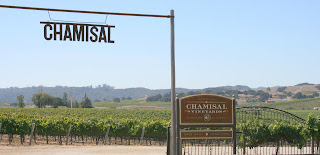Carmel
is known for many things –
The old world charm of Carmel draws people from across the globe and one of the novelties is that there are not any addresses, seriously. Directions are given as: “on 7th between San Carlos Ocean Ave. ,” but the town is immensely walkable. Known for shopping, there are plenty of clothing stores, a few antique stores and tons of art galleries. The best is the Carmel Art Association; a co-op of 120 talented artists all of whom live within a 30-mile radius. The association was founded in 1927 and you will find oil and pastel paintings, wood and ceramic sculpture and whatever an artist dreams up. Artists bring in new works on the first Wednesday of each month, ensuring a constant rotation.
 |
| Wrath Tasting Room |
The pristine white sand of the Carmel City Beach is dog friendly too. As you stand at the water’s edge to your right is
For a fabulous meal, consider Mundaka, a tapas restaurant styled in the Spanish motif in a casual, informal environment, something a little unusual for Carmel
 |
| The Carmel City Beach |
 |
| Breakfast at Em Le's |
 |
| Hofsas House |
End your days at the family-owned Hofsas House, a terrific dog-friendly hotel. I’ve stayed here many times and the 4th floor rooms with Dutch doors are the best with their views across the Cypress trees to the Pacific Ocean. The rooms are large, a few antiques scattered about and it’s comfortable and casual allowing you to relax. They have a year-round heated outdoor pool, a European dry sauna and an informal continental breakfast available in the lobby of coffee, yogurt and pastries. There is wireless access, and it’s an easy four block walk to the town core. They accommodate lots of large gatherings like family reunions and clubs, and have a dedicated building for just this kind of thing. And they have their own parking lot. That might seem like a non-mention, but many hotels in Carmel Carmel
EAT:
STAY:
DO:


































